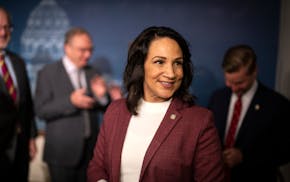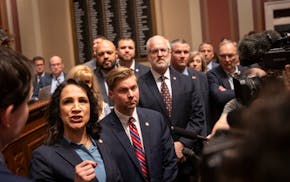Community members have until early August to comment on an environmental plan for the proposed $3 billion Blue Line light-rail extension that will connect Target Field with Brooklyn Park.
The 13.4-mile Blue Line, whose route also travels through north Minneapolis, Robbinsdale and Crystal, is expected to begin service in 2030. A key step in the planning process, announced by the Metropolitan Council and federal funders on Friday, involves the release of a supplemental draft environmental impact statement.
The plan outlines the potential social, economic and environmental pros and cons associated with building the project, the fourth, and likely last light-rail project in the metro. It is expected to cost between $2.9 billion and $3.2 billion, surpassing the Southwest light-rail line as the most expensive public works project in state history. Daily ridership is expected to hit nearly 30,000 by 2045.
"This is a major benchmark for the project," said Met Council Chair Charlie Zelle during a Blue Line extension meeting Thursday. "It starts the clock to officially receive public comment."
The Blue Line extension, which has been planned for more than a decade, is now on its third route.
The first, which largely operated within freight railroad right-of-way, was abandoned in 2020 after rail giant BNSF Railway indicated it wasn't interested in sharing. The current plan through north Minneapolis shifted after neighbors in Lyn Park expressed concerns about light rail bisecting their neighborhood.
The environmental plan released Friday "is a real shift for the project, a good thing," Zelle said.
The plan is available online, where members of the public may comment online, through a hotline (612-373-3970), and at community events. Public hearings are scheduled for July 16 and July 23.
The deadline for comments is Aug. 5.
The plan notes property acquisition will be required in all four cities to be served by the line. Of the 36 relocations identified, 27 of them are in Minneapolis. The plan states compensation and relocation assistance will be offered to property owners.
For more than a year, property owners, businesses and residents mostly in north Minneapolis have expressed concerns and frustration about possibly being displaced by the project.
The Met Council and Hennepin County Board engaged University of Minnesota's Center for Urban and Regional Affairs to craft a roadmap to help "navigate the human side of building a light rail route." A group of residents, businesses, community organizations and non-profits met for 18 months to discuss those challenges; recommendations were released last year.
The Legislature this year set aside $10 million to help those displaced along the Blue Line route, part of $40 million allocated in 2023 to support the project.
The plan notes construction may affect the habitat for Northern long-eared and tricolored bats, Blanding's turtles, Monarch butterflies and migratory birds.
It also notes that 15 properties, about 173 dwelling units, will be severely affected by noise, a fact brought up by some residents in the North Loop, who have proposed the line be changed from light rail to bus-rapid transit. Some residents in Robbinsdale are also pushing for BRT, saying it would be safer and more cost effective.
The public's comments will be included in a final environmental plan. Cities along the line will decide whether to grant municipal consent beginning late summer into early fall.
New Minnesota GOP leaders seek peace with party's anti-establishment wing

Who is Republican Lisa Demuth, Minnesota's first House speaker of color?

Minnesota House GOP, Secretary of State Steve Simon return to Supreme Court
Supreme Court sides with DFL and Simon, says 68 House members needed for floor action

